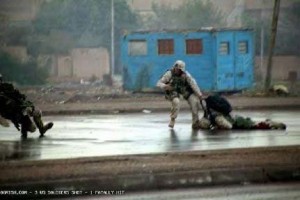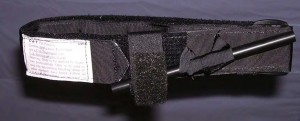a. Medical personnel’s firepower may be essential in obtaining tactical fire superiority.
Attention to suppression of hostile fire may minimize the risk of injury to personnel and minimize additional injury to previously injured soldiers. The best offense on the battlefield is tactical fire superiority. There is little time available to provide care while under enemy fire and it may be more important to suppress enemy fire than stopping to care for casualties. The tactical situation will dictate when and how much care you can provide. Finally, when a medical evacuation (MEDEVAC) is requested, the tactical situation may not safely allow the air asset to respond.
b. Personnel may need to assist in returning fire instead of stopping to care for casualties. This may include wounded soldiers that are still able to fight.
c. Wounded soldiers who are unable to fight and who are exposed to enemy fire should move as quickly as possible to any nearby cover. If no cover is available or the wounded soldier cannot move to cover, he should lie flat and motionless (play dead).
d. Figure 1-1 depicts a tragic situation. A wounded Marine is down in the street. A colleague attempts to come to his rescue along with a second Marine. Enemy fire continues in the area and the first rescuer is critically wounded. The second rescuer returns behind cover. Eventually, after enemy fire is contained, the first wounded Marine is rescued and the initial rescuer is permanently disabled.

The point is, when under enemy fire, we cannot afford to rush blindly into a danger area to rescue a fallen comrade. If we do, there may be additional soldiers wounded or killed attempting to rescue our wounded.
e. Medical personnel are limited and, if they are injured, no other medical personnel will be available until the time of evacuation during the CASEVAC phase.
f. No immediate management of the airway is necessary at this time due to the limited time available while under enemy fire and during the movement of the casualty to cover. Airway problems typically play a minimal role in combat casualties. Wounding data from Viet Nam indicates airway problems were present in only about one percent of combat casualties, mostly from maxillofacial injuries.
g. The control of hemorrhage (major bleeding) is important since injury to a major vessel can result in hypovolemic shock in a short time frame. Extremity hemorrhage is the leading cause of preventable combat death.
NOTE: Over 2,500 deaths occurred in Viet Nam secondary to hemorrhage from extremity wounds; these casualties had no other injuries.
h. The use of temporary tourniquets to stop the bleeding is essential in these types of casualties. If the casualty needs to be moved, as is usually the case, a tourniquet is the most reasonable initial choice to stop major bleeding. Ischemic damage to the limb is rare if the tourniquet is left in place for less than one hour (tourniquets are often left in place for several hours during surgical procedures). In addition, the use of a temporary tourniquet may allow the injured soldier to continue to fight. Both the casualty and the soldier medic are in grave danger while applying the tourniquet and non-life-threatening bleeding should be ignored until the tactical field care phase.
i. The need for immediate access to a tourniquet in such situations makes it clear that all soldiers on combat missions have a suitable tourniquet, such as the Combat Application Tourniquet (CAT) shown in figure 1-2, readily available at a standard location on their battle gear and that soldiers be trained in its use.

j. Penetrating neck injuries do not require cervical spine (C-spine) immobilization. Other neck injuries, such as falls over 15 feet, fast roping injuries, or motor vehicle collisions (MVC), may require C-spine immobilization unless the danger of hostile fire constitutes a greater threat in the judgment of the soldier medic. Studies have shown that, with penetrating neck injuries being only 1.4 percent of the injured, few would have benefited from C-spine immobilization.
Adjustable rigid cervical colors (C-collars) should be carried in the soldier medic’s medical aid bag. If rigid C-collars are not available, a SAM splint from the aid bag can be used as a field expedient C-collar.
k. Litters may not be available for movement of casualties.
(1) Consider alternate methods to move casualties, such as ponchos, pollens litters, SKEDCO or Talon II litters, discarded doors, dragging, or manual carries).
(2) Smoke, CS (2-chlorobenzalmalononitrile, a type of riot control gas), and vehicles may act as screens to assist in casualty movement.
l. Do not attempt to salvage a casualty’s rucksack unless it contains items critical to the mission. Take the casualty’s weapon and ammunition, if possible, to prevent the enemy from using them against you.
m. Key points.
(1) Return fire as directed or required.
(2) The casualty should also return fire if able.
(3) Direct the casualty to cover and apply self-aid, if able.
(4) Try to keep the casualty from sustaining any additional wounds.
(5) Airway management is generally best deferred until the tactical field care phase.
(6) Stop any life-threatening hemorrhage with a tourniquet or a HemCon™ Bandage, if applicable.
